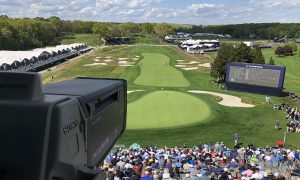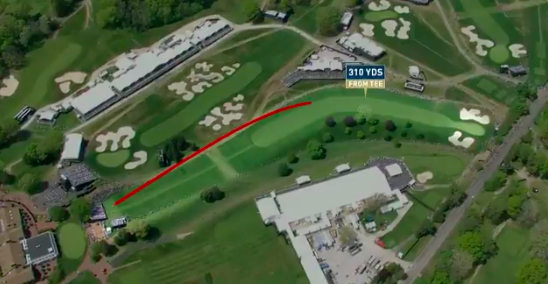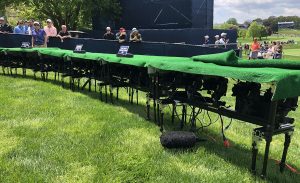Live From the PGA Championship: CBS Sports’ Tech Toys Include SIMI Motion Capture, Aerial Toptracer, 4DReplay
New technologies offer new perspectives and better understanding of the sport
Story Highlights
Each year, CBS Sports uses the PGA Championship to showcase the latest breakthroughs in live-production technology. This year, the broadcaster is once again upping the tech ante, deploying a bevy of next-gen production tools, including the debut of SIMI motion-capture technology and Toptracer aerial-tracing technology from the blimp camera.
“The PGA Championship has really become our annual technology showcase event,” says Mike Francis, VP, remote engineering and planning, CBS Sports. “PGA of America is a great partner, and they are always interested in what’s new and what we can do to help showcase their event in creative ways. They’ve been really good about allowing us to deploy new technologies and try new things out here.”
On top of the SIMI motion-capture and Toptracer aerial tracing, CBS Sports has brought back several of its high-tech staples from recent years: 4DReplay at No. 15, Hawk-Eye Green Technology, Toptracer systems at all 18 holes (plus two RF systems), ARL Virtual Eye, Smartcart, and wind metering on every hole. In addition, it is once again producing 4K HDR coverage from the final three holes.
SIMI Motion Capture Goes Under the Skin on Tee Shots
Having been used on a U.S. network for the first time ever at last month’s Masters Tournament in Augusta, SIMI motion-capture technology is deployed at Bethpage Black’s 11th tee. The breakthrough technology highlights player swings and displays full-body skeletor analytics, covering hip and shoulder rotation, arm- and knee-contortion angles, and the speed of the golf club both before and after impact. CLICK HERE for video of SIMI motion-capture technology on CBS.
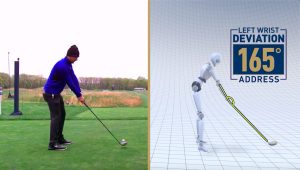
SIMI motion capture displays full-body skeletor analytics — hip and shoulder rotation, arm- and knee-contortion angles —and golf-club speed.
During Wednesday’s practice round, the system featured eight high-end industrial cameras (all connected via three strands of fiber) surrounding the 11th-tee box to capture skeletor analytics of each player’s swing. Seven cameras were placed on 15-ft. truss sticks covering about 270 degrees; the eighth camera was placed at the top of the camera tower on the 10th green facing the 11th-tee box.
These cameras were fed to the truck, where they were integrated to create a stitched 3D environment. Within the 3D environment, the SIMI Team 3-D uses custom algorithms to detect all the muscles, bones, and joints to track the movement of the skeletal body within this 3D space. The final 3D model of each player and all the accompanying data are pushed out to graphics editors at the CBS Broadcast Center in New York City, who overlay the 3D model with footage captured by one of CBS’s SwingVision Phantom v642 cameras during the live broadcasts Thursday-Sunday.
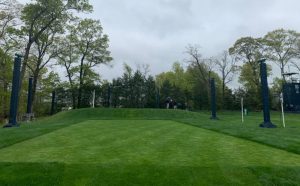
For SIMI motion capture, eight industrial cameras (connected via three strands of fiber) surround the 11th-tee box.
“Motion capture has been around for quite some time, but it hasn’t been achievable for live-sports because you just can’t put devices on the players during the course of play,” says Jason Cohen, VP, remote technical operations, CBS Sports. “The technology we’re using here allows us to do motion capture with just optical sensors in the cameras, so we don’t have to ask players to wear anything. To be able to capture the data of what exactly a player’s body is doing during that exact moment off the tee — without impacting him in any way — was obviously really appealing to us.”
He adds that CBS plans to feature more side-by-side comparisons of two golfers this weekend during the telecast.
“Where this technology really starts to help tell the story,” he says, “is when we have Golfer A video with his skeletor compared to Golfer B video with his skeletor side by side. You can see how one golfer approaches his swing versus another. People are really starting to understand the potential of being able to dissect the human body in a scientific way to understand why balls go farther or someone’s swing is faster. I think that you’re going to see this technology begin to erupt in golf, in other sports, and in industries outside of the sports broadcasting as well.
Toptracer Takes to the Skies: Tracing Shots from the Blimp
For the first time on any golf broadcast, CBS is using Toptracer over live video from the blimp. CBS partnered with Winged Vision, founded by Sports Broadcasting Hall of Famer Bob Mikkelson, and ARL to create a system that combines blimp footage with Virtual Eye Hero technology and Toptracer to provide complete shot trajectory for the players from tee to green. CLICK HERE for video of aerial Toptracer on CBS.
“Traditionally,” says Cohen, “we’ve always been able to look at the tracing from either the tee box or a second shot but solely from the ground perspective. While [Toptracer is] certainly an incredible tool, at a certain point, the ball leaves the vicinity, and the trace kind of tails off with it. Then you cut to another camera to show where the ball landed. Now, from this previously unseen perspective, you get the entire flight path of the ball as it happens.”
In addition to the live tracing, CBS can also use the Toptracer blimp system to display multiple golf shots at once to compare how different golfers played the same hole or how one player played the same hole on different days.
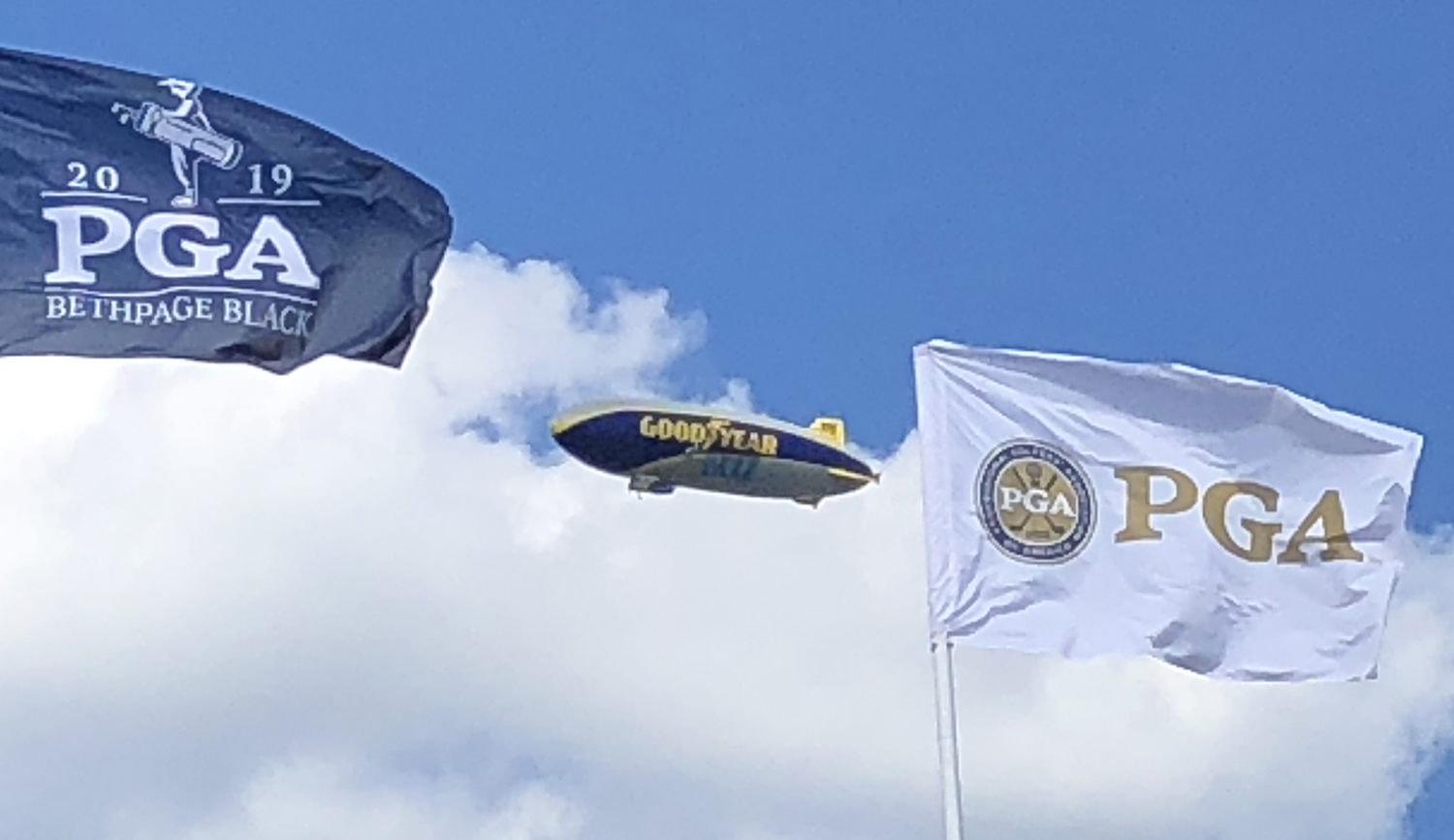
Covering the PGA Championship at Bethpage Black, the Goodyear Blimp is providing Toptracer aerial technology for the first time.
To provide deeper analysis, CBS also plans to marry the Toptracer aerial data with drone footage that it shot of every hole prior to the tournament.
“We’ve always used drones to show how the golfer should play a hole, but now we can now tell you how the golfer actually played the hole from the drone’s perspective,” says Cohen. “We can also show two Toptracer graphics at the same time to analyze how Golfer A played the hole vs. Golfer B. The drone footage is already loaded into their tracking system, so, as soon as the shot happens, the tracing data is available, and it could be a first replay [in the telecast].”
4DReplay Doubles Cameras To Enhance 180-Degree Look
CBS Sports will also bring back 4DReplay for the pivotal Hole 15 tee box at Bethpage Black. Having deployed it for the first time on a U.S. golf broadcast at last year’s PGA Championship at Bellerive, CBS has doubled the number of miniature 4K cameras this year to 90, allowing an even better video display of the swing to showcase a 180-degree look around the player. All 90 cameras are synchronized and fed to the truck via a single strand of fiber to be processed into a three-dimensional environment for 180-degree replays.
“We debuted 4DReplay here last year,” says Francis, “and it was a big hit for both the viewers and our analysts. The additional cameras this year not only help us get that wider range — up to 180 degrees at this point — but they also make the pan and rotations smoother since there’s not as many gaps to fill between images as they get rendered.”
4DReplays can now be turned around in under 30 seconds, making them available for first replays immediately following players’ tee shots on Hole 15.
“4D has come a long way,” says Cohen. “Now that the process time is under 30 seconds, it has become a great tool for the production team. SwingVision technology gives you a nice slow-motion replay of a player’s swing from one perspective, but, with 4D, we’re able to not only start in the front of him but also go all the way around the side of him. That allows us to show the audience perspectives that were not available before. That gives a better understanding of how these professionals are attacking their game.”
More in CBS’s Tech Treasure Chest: Hawk-Eye Green Tech
CBS Sports is once again deploying Hawk-Eye Green Technology at the PGA Championship, including the Putt Predictor and undulation grid on Holes 11, 12, 15, and 17. Putt Predictor demonstrates the extreme differences in the line that a putt can travel and still go in, based on weight of the ball strike. It provides a shaded area between the line of a hard putt to the back of the hole and a soft-putt line that has the most movement. If a putt leaves the shaded area between the two lines, the viewer knows that it will not drop. In addition, the graphic undulation grid is overlaid on a green along with moving arrows to highlight its undulations.
Smartcart, which has become a staple of CBS Sports’ golf coverage in recent years, is also on hand for CBS’s Saturday and Sunday coverage. The 72-in. mobile screen, mounted on a custom-fitted golf cart for broadcast applications, will be used to analyze and telestrate such data as golf swings and shots, difficulty of holes, and scorecards.
With Pinpoint Wind technology, CBS will also provide detailed analysis of wind conditions at Bethpage for all 18 holes and will place anemometers strategically around the course to illustrate the weather and wind patterns during tournament days.
